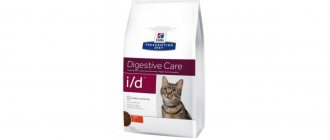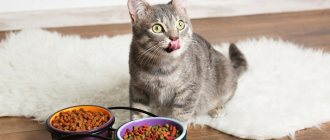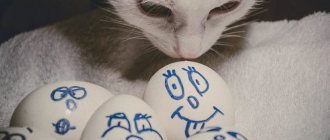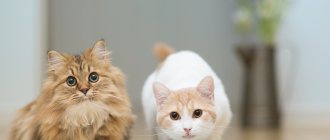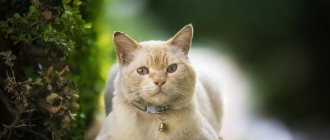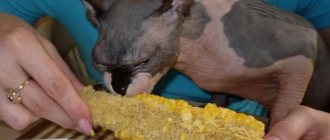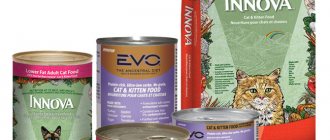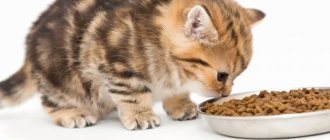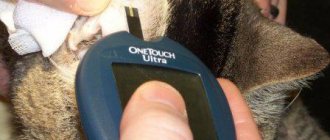Urolithiasis (urolithiasis) occurs in every fourth cat. This is a serious health threat that reduces your pet's quality of life.
Nutrition is one of the causes of ICD. At the same time, a proper diet is a way to change the well-being of an animal suffering from this pathology for the better. There are special foods for cats with urolithiasis. Their main task is to dissolve stones in the bladder and prevent the formation of new ones. And in some cases, veterinary foods can replace medications.
The danger of urinary stones
Cat urine contains soluble and insoluble salts. If the animal is healthy, the substances are excreted in urine. When metabolic processes in the body are disrupted, the amount of insoluble elements increases, which gradually turn into sand. And stones (uroliths) are formed from sand. They can be very small or reach the size of a walnut. The cat experiences discomfort when the stones begin to injure the mucous membrane of the bladder and urethra (urethra).
The most serious threat is blockage of the urethra with a stone. The condition is possible only in cats and threatens the animal with death from intoxication and rupture of the bladder.
What is struvite in cats?
Older cats are susceptible to diseases of the excretory system. In addition to inflammation of the bladder and kidneys, pets often suffer from urolithiasis. (ICD). The cat's waste is eliminated in the form of salts in urine. Their solubility has its limits.
An increase in salt concentration, a change in pH, and the appearance of crystallization nuclei lead to the formation of solid deposits that impede the outflow of urine. Concretions are grouped into grains of sand or stones. They can clog the urinary duct, which poses a threat to the animal’s life.
Stones of different chemical compositions are formed in the urine of cats, but most often Struvite is formed. Therefore, the term is used when it comes to uroliths in general.
Nutrition: enemy and ally
Malnutrition in cats is one of the provoking factors for the development of urolithiasis. Therefore, when choosing food, you need to consider the following nuances:
- A number of feeds contain excess amounts of phosphorus, magnesium, and calcium. These elements contribute to the formation of crystals in urine.
- The food has a significant effect on the acidity of urine (pH). The cat’s body is “tuned” to digest animal food, which makes the urine slightly acidic, and therefore prevents the formation of stones. In such an environment, crystals dissolve. If the diet is dominated by products of plant origin, which is often found in cheap brands, the pH of the urine shifts towards slightly alkaline. And this contributes to the formation of struvite - one of the most common types of stones.
The likelihood of developing the disease increases if the cat drinks little. In this case, the urine becomes too concentrated and stones form faster.
Prevention of urolithiasis
It is easier to prevent urolithiasis than to try to save your sick pet later. It is important to monitor your pet’s diet (the diet must be balanced). The cat should drink clean filtered water, not get too cold, move more, and not be obese. But even if you follow these rules, you cannot completely protect your pet from ICD (after all, there are also hereditary and age-related prerequisites).
The development of KSD is affected not only by poor nutrition, but also by lack of fluid, which is why it is important to ensure that the cat always has access to clean water (preferably filtered)
It is recommended to regularly take your cat for preventive examinations to the veterinarian, even if there are no signs of pathology (in the early stages, the clinical picture of urolithiasis is blurry). A chemical analysis of urine will reveal a predisposition to struvite, oxalate or other stones. If any deviations from the norm are detected, treatment should be started immediately - the sooner it is started, the greater the chance of a complete recovery of the animal without subsequent relapses.
All cats are susceptible to urolithiasis. Some people have a congenital predisposition. Some people develop pathology due to poor food, obesity, or hypothermia. It is important for a person to closely monitor the well-being of a pet. If a cat refuses to eat, urinates poorly, or screams in pain, you should urgently take the animal to the clinic. The stones will not dissolve on their own; to remove them, a complex of medications or surgery is required.
Features of nutrition with ICD
The physiology of cats has a peculiarity - animals rarely experience thirst, and their urine is highly concentrated. The goal of medicinal food for urolithiasis is to make pets drink a lot and go to the toilet more often. To make the cat thirsty, salt (sodium) is added to the composition. With frequent urination, the crystals are washed out and stones do not have time to form.
Moreover, if there is too much salt, the kidneys begin to secrete more calcium, which promotes the formation of oxalates. Therefore, it is up to the veterinarian to decide what to feed the cat.
Regardless of what type of stones are found (urate, phosphate, oxalate), on average, a cat on a dry diet should drink 150-200 ml of water. If he drinks reluctantly, then little urine is produced. For a cat, this threatens to block the urethra. In such a situation, you need to feed a cat with urolithiasis canned food or force it.
When therapeutic feeding, it is important to exclude any other foods from the diet, these also include treats and vitamins.
Why should a doctor select food?
For urolithiasis, complex treatment is carried out. Diet therapy is only one of the measures.
It is important to consider the danger of excessive acidification of urine and avoid it. Severe acidification leads to disruption of the acid-base balance, the development of chronic renal failure, and the occurrence of osteoporosis.
A specific medicinal food for cats with urolithiasis is prescribed by a doctor. Before this, laboratory tests of urine sediment are required to suggest the type of stones formed.
Food for cats with urolithiasis should be:
- Well digestible.
- Calorie. The higher the energy value and fat level, the less volume is eaten and the less minerals are supplied.
- Capable of making urine acidic (pH 6-6.5) with struvite and neutral with oxalates.
- Optimal in terms of the ratio of sodium, calcium in case of suspected oxalates.
There is no universal food that would be suitable for both the struvite type of ICD and the oxalate type.
What to feed a cat with struvite
In cats, the most common type of urolithiasis is struvite type. The risk group includes animals aged 2 to 6 years.
Struvite are stones that form phosphates. These salts are normally found in urine, but when it becomes alkaline (pH greater than 7), they precipitate. Such uroliths can only dissolve in an acidic environment (pH 6.3 or less). Slightly acidic urine is caused by foods that contain a high proportion of animal ingredients. In the composition, meat should come first.
As a rule, for cats with struvite urolithiasis, food with a low magnesium content is selected - 0.12% or less. This component promotes the formation of stones. But for the occurrence of stones, a big role is played not by how much magnesium is specifically contained in the food, but by how much the cat receives in one serving. It is believed that animals should be given small doses, but more often, or food should be left in constant access.
A number of manufacturers have a veterinary line "Urinari" for cats with problems with the urinary system.
| Brand | Name | Additional Information |
| Hills | Prescription Diet Feline S/D | Prescribed for struvite. Has an acidifying effect. Magnesium level is low - 0.068%. Calorie content – 417 Kcal/100g. They are used for 1 to 2 months (on average) and then maintenance dietary Hills C/D is prescribed. |
| Prescription Diet Metabolic + Urinary Feline | Suitable for overweight animals. The manufacturer informs that struvite dissolution is possible within a week (individually for each animal). Maintains urine pH level in the range of 6.2 – 6.4. Contains the amino acid methionine, which has an acidifying effect. Calorie content – 339 Kcal/100g. The percentage of magnesium is 0.07. | |
| Royal Canin | Urinary S/O | Designed to dissolve struvite. Magnesium: 0.05%. Available in the form of croquettes, pate, canned food. |
| Happy Cat | VET Diet Struvit | German-made food for cats from six months. Magnesium level – 0.05%. |
| Farmina | Adult Cat Urinary |
Risk factors
Breed predisposition.
The Ragdoll, British Shorthair, Havana, Scottish Fold, Persian, and Himalayan breeds are predisposed to the formation of oxalates.
Insufficient water consumption.
This is a risk factor common to all types of stones.
Unbalanced diet
. The risk of calcium oxalate crystals depends on the concentration of calcium and oxalate ions in the urine. Products with a high calcium content include some types of fish (herring, salmon), and average calcium content in dairy products (cheese, milk, yogurt). The appearance of uroliths is influenced by a deficiency of vitamin B6 (pyridoxine) in the diet and excess vitamin D.
A significant deficiency of magnesium (which must be reduced to normal, for example, in a diet for struvite type stones) is a risk factor for oxalate type stones, since magnesium is able to effectively bind oxalates, preventing the formation of crystals.
Acidification of urine.
The most important dietary factor for the oxalate type of KSD in cats is urine acidification. Cats have a preference for acidic supplements, so many cat treats shift the urine pH to the acidic side. The high protein content in the feed, which is typical for both homemade diets and high-end commercial diets, also has an acidifying effect.
Diet of castrates with urolithiasis
There is an opinion that castration slows down the metabolism in the body. Therefore, neutered cats are at risk of developing urolithiasis. This version is considered incorrect. In fact, stones in castrati occur primarily due to the fact that they begin to lead a sedentary lifestyle, which slows down their metabolism.
In this category of animals, veterinary diets are used not only for the treatment, but also for the prevention of urolithiasis. The digestion of a castrated cat and a regular cat is no different, so all the above-described foods are suitable.
Preventive diet
The greatest importance for preventing the development of urolithiasis is what to feed the cat after urolithiasis.
For everyday nutrition and at the same time prevention, you need sufficiently high-calorie food, consisting mainly of animal ingredients - meat and fish.
Animal protein contains amino acids that maintain an optimal level of urine acidity (6-6.5 pH). Cereals are high in sodium and alkaline your urine. Therefore, a diet with a large proportion of grains is not suitable for cats either for the treatment or prevention of struvite-type urolithiasis. Only corn gluten also acidifies urine, so its presence in the composition is acceptable. However, most industrial feeds contain a significant percentage of cereals. This means that you need a careful approach to choosing a specific brand.
An important measure to prevent urolithiasis is drinking regime. The cat must consume sufficient fluids. It is better not to give tap water to animals, but to use filtered or bottled water. Water must be constantly available. Animals do not like stagnant water, so it needs to be changed as often as possible.
Hill's brand food is suitable for prevention:
- Prescription Diet Feline C/D. The product minimizes the risk of struvite formation. Suitable for long-term use. The food is available in two varieties - based on chicken and sea fish. Calorie content 388 kcal/100 g. Contains minimal amounts of magnesium and phosphorus.
- With the oxalate type, the level of phosphorus and magnesium is not reduced. Should be less sodium and protein. Therefore, food lines S and C are not suitable. To prevent oxalates and other types of uroliths, such as cystines, you need the Hills K/D diet.


